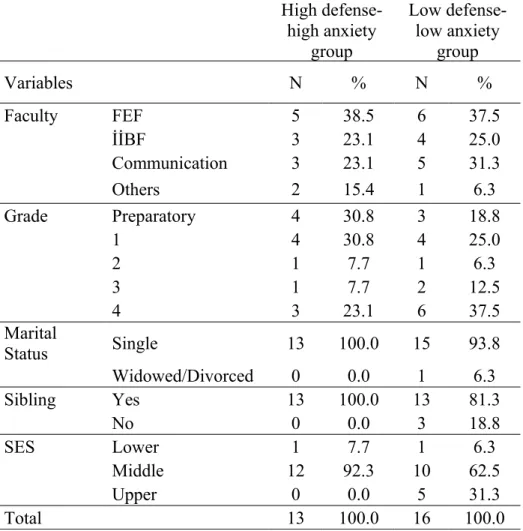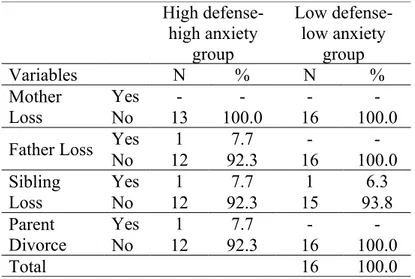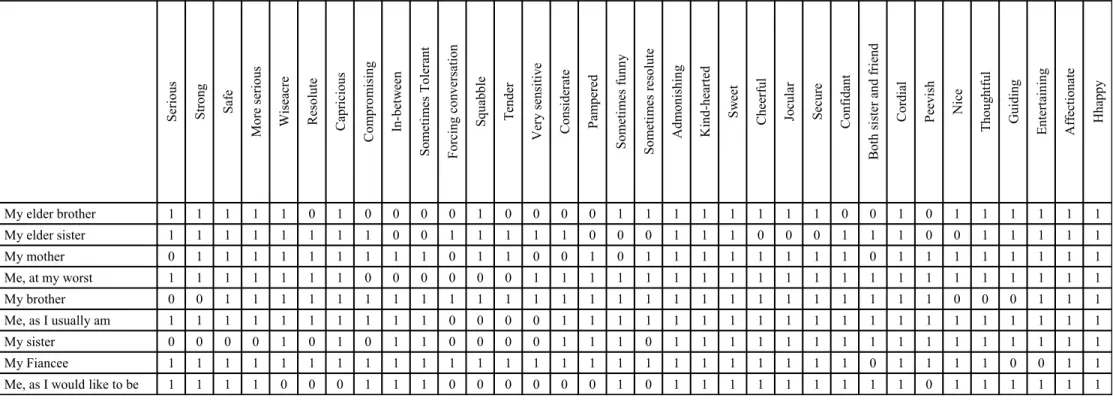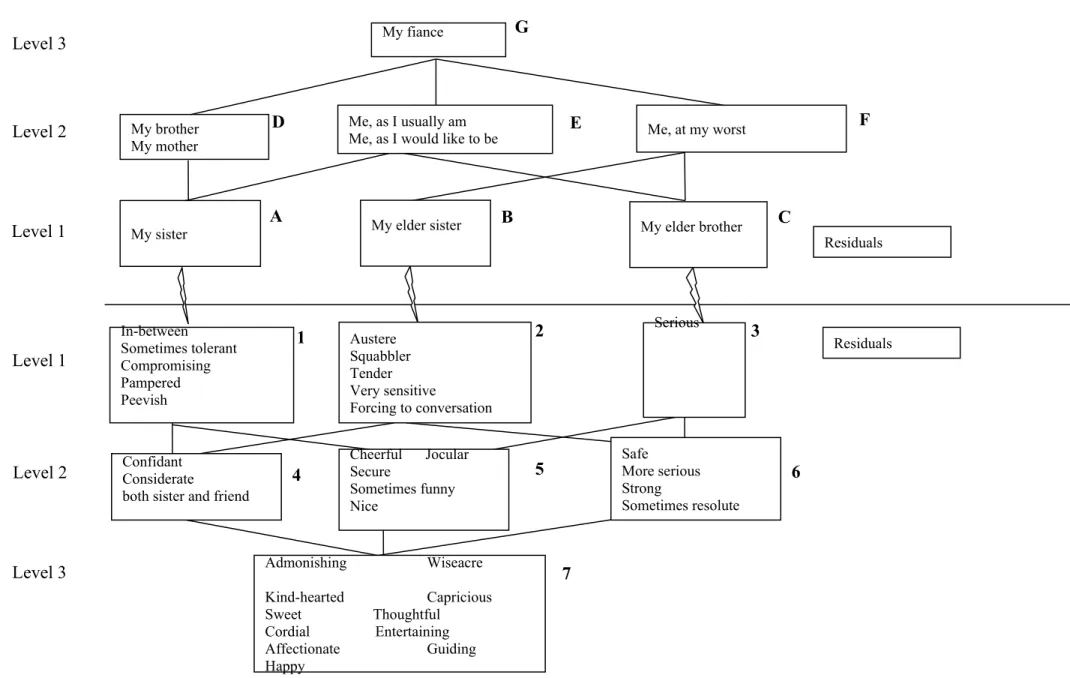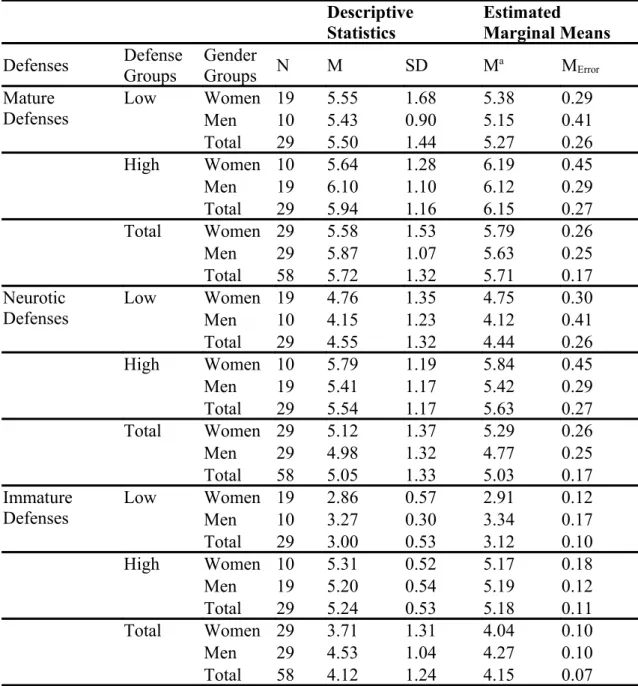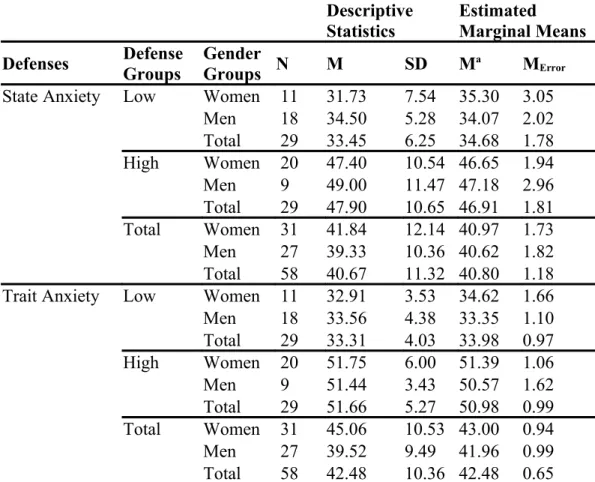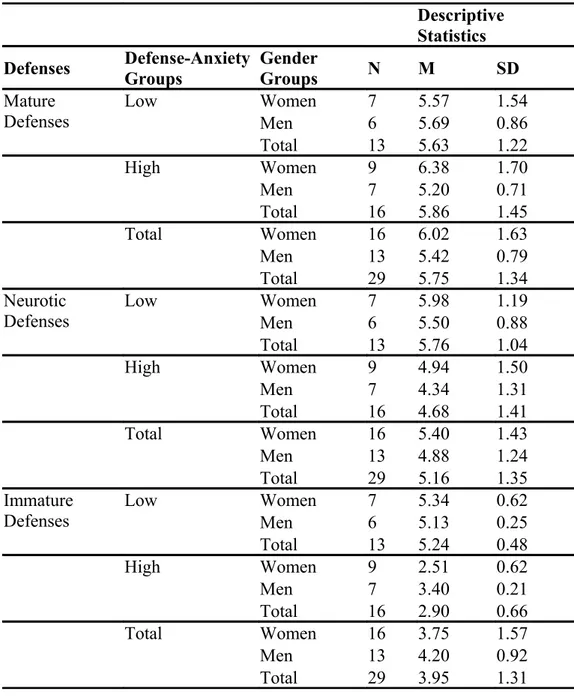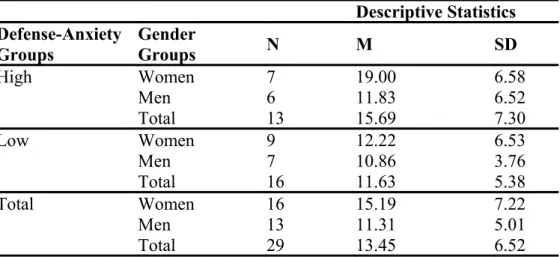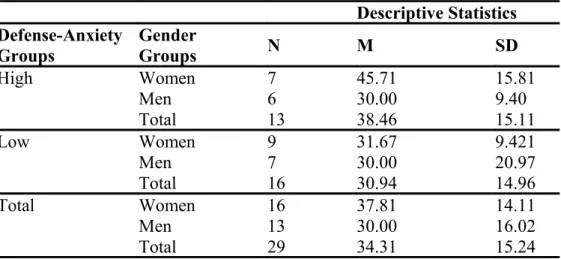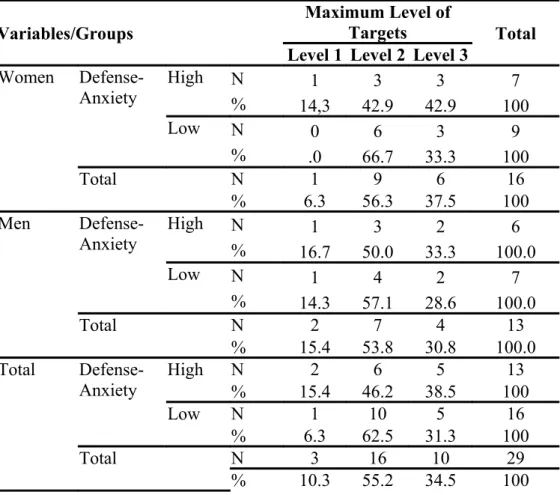A STUDY OF THE RELATIONSHIP OF SELF-WITH-OTHER REPRESENTATIONS WITH DEFENSE MECHANISMS
FİLİZ YURTSEVEN 107629004
İSTANBUL BİLGİ ÜNİVERSİTESİ SOSYAL BİLİMLER ENSTİTÜSÜ PSİKOLOJİ YÜKSEK LİSANS PROGRAMI
YAVUZ ERTEN, MA 2010
A STUDY OF THE RELATIONSHIP OF SELF-WITH-OTHER REPRESENTATIONS WITH DEFENSE MECHANISMS
FİLİZ YURTSEVEN 107629004
İSTANBUL BİLGİ ÜNİVERSİTESİ SOSYAL BİLİMLER ENSTİTÜSÜ PSİKOLOJİ YÜKSEK LİSANS PROGRAMI
YAVUZ ERTEN, MA 2010
A Study of the Relationship of Self-with-Other Representations with Defense Mechanisms
“Ötekiyleyken Ben” Temsilleri ve Savunma Mekanizmaları Arasındaki İlişki
Filiz Yurtseven 107629004
Yavuz Erten, MA : ………
Asst. Prof.Dr. Murat Paker : ……….
Prof.Dr. Öget Öktem Tanör : ……….………
Approval Date : 04.02.2010
Total Page Number : 151
Anahtar Kelimeler Key Words
1) temsil 1) representation
2) ötekiyleyken ben 2) self-with-other
3) ben temsilleri 3) self representations
4) savunma mekanizmaları 4) defense mechanisms
ABSTRACT
A Study of the Relationship of Self-With-Other Representations with Defense Mechanisms
Filiz Yurtseven
This study aims to explore the relations among structural qualities of “self-with-other” representations (“me as usual”, “me as ideal”, and “me at my worst”) and associated self-representations vis-à-vis defense mechanisms and levels of anxiety. The research sample consisted of 39 male and 45 female undergraduate students (totaling 84) from Istanbul Bilgi University. Data were collected via “Self-with-other Questionnaire”, “Defense Styles Questionnaire” and “State-Trait Anxiety Inventory. For the purpose of generating self and self-with-other representations, Hierarchical Classes Analyses (HICLAS) clustering method was also utilized. Main findings of the study suggested a positive relationship between anxiety and defense mechanisms, and male and female respondents were found to be different in the use of immature defenses. No statistically significant differences between high and low defense-anxiety groups in terms of representations were found. Secondly, the study revealed that while female respondents provided both positive and negative self-with other portrayals; male respondents’ representations were predominantly positive. Thirdly, results demonstrated that significant others of both respondent groups were mostly friends, who were followed by mothers. Finally, while “me as ideal” and
“me as usual” representations were found to be more integrated within the overall organization; “me at my worst” was more rejected when compared to other representations. In conclusion, it must be emphasized that findings of the study provided strong support for the relations between anxiety, defense mechanisms and representations, with an emphasis on gender differences and representational qualities were in line with previous researches in Turkey.
ÖZET
“Ötekiyleyken Ben” Temsilleri ve Defans Mekanizmaları Arasındaki İlişki Filiz Yurtseven
Bu çalışma “ötekiyleyken ben” temsillerinin yapısal özelliklerinin ve bu temsil yapısı dahilinde üç “ben” temsilinin (“genelde olduğum halimle ben”, “olmak istediğim halimle ben”, “en kötü halimle ben”) savunma mekanizmaları ve kaygı ile ilişkisini araştırmayı amaçlamaktadır. Araştırmanın örneklemi 39’u erkek ve 45’i kadın olmak üzere 84 İstanbul Bilgi Üniversitesi lisans öğrencisinden oluşmaktadır. Veriler “Ötekiyleyken Ben Anketi”, “Savunma Biçimleri Testi” “Durumluluk-Süreli Kaygı Envanteri” aracılığıyla toplanmış ve “Kendilik” ve “Ötekiyleyken Ben” temsillerini elde edebilmek için Hiyerarşik Sınıflar Analizi (HICLAS) metodu kullanılmıştır. Elde edilen veriler doğrultusunda kaygı ve savunma arasında pozitif bir ilişki saptanmış ve kadın ve erkek katılımcılar olgun olmayan savunmalar açısından farklılık göstermiştir. Kaygı düzeyi-savunma mekanizmaları ile temsiller arasındaki ilişki istatistiksel olarak anlamlı olmayan düzeyde gözlemlenmiştir. İkinci olarak, erkek katılımcıların temsilleri ağırlıklı olarak olumluyken, kadın katılımcıların ötekiyleyken ilişkide kendilerini hem olumlu hem olumsuz algıladıklarını görülmüştür. Her iki gruba ait katılımcıların da hayatlarındaki önemli kişilerin daha çok arkadaşlarından ve sonra anneden oluştuğu tesbit edilmiştir. Son olarak, çalışmanın bulguları ışığında “olmak istediğim” ve “genelde olduğum” halimle ben “ötekiyleyken ben” organizasyonda daha entegre olduğu
gözlemlense de, “en kötü halimle ben” temsilinin diğer “ben” temsillerine göre daha fazla reddedilen temsil olduğu saptanmıştır. Nihai bulgular, kaygı, savunma mekanizmaları ve temsiller arasındaki ilişkiyi, cinsiyet farklarına da vurgu yaparak, desteklemiş ve genel temsil yapısı özelliklerinin Türkiye’de yapılmış diğer araştırmaların bulguları ile örtüştüğü sonucuna ulaşılmıştır.
ACKNOWLEDGEMENTS
This thesis would not have been possible without the support of many people. There are some people who made this journey easier with words of encouragement and more intellectually satisfying by offering different places to look to expand my ideas. I would like to express my gratitude to all those who gave me the possibility to complete this thesis.
Firstly, I am profoundly thankful to my thesis advisor, psychoanalyst and clinical psychologist Yavuz Erten, whose encouragement, guidance and support from the initial to the final level enabled me to develop an understanding of the subject. Furthermore, his wide knowledge and his logical way of thinking have been of great value for me and provided a dense basis for the thesis.
I am deeply grateful to Asst. Prof. Murat Paker for his detailed review, constructive comments and criticism, and his important support throughout this work. I am also deeply indebted to Prof. Dr. Öğet Öktem from Istanbul University whose encouragement helped me throughout the writing and presenting process of my thesis.
I wish to thank Erkan Kalem for his guidance and essential assistance in statistical analysis. I offer my regards and blessings to Veysel Eşsiz, who vastly contributed to the final version of the thesis in terms of language and grammar. A special thanks goes to Dan Ogilvie who was
abundantly helpful and offered invaluable support and guidance in terms of using the HICLAS program used in this thesis.
My colleagues, Alev Çavdar, Ayşegül Kumanlı Güneş, Hande Özyıldırım Dündar, Gülcan Akçalan and Elif Bolcan Sessiz from the Psychological Counselling Unit at Istanbul Bilgi University supported me in my work during the thesis. I want to thank them for all their support, interest, valuable hints and friendly help. Especially, I am grateful to Alev Çavdar for her valuable suggestions which helped me in deciding on my thesis subject, and her help in analysis, and her advice throughout this work. She is like a sister to me, owing to her great help in all difficult times in my life. In addition, I wouldn't be performing this work without Elif Bolcan Sessiz’s continual encouragement and support.
I would also like to gratefully acknowledge the support of some very special individuals, Berrin Anar, Beyhan Sunal, Mehmet Ergene, Ateş Çavdar, Elif Eroğlu, Berrak Karahoda, Perihan Güler Özden, Didem Sözen and Çiğdem Tiryaki. They helped me immensely by offering their contributions, encouragement and friendship.
I am indebted to my teachers and friends from primary to graduate school for providing a stimulating and pleasurable environment in which I could learn and grow. I am especially grateful to the academic staff of Istanbul Bilgi University Psychology Graduate Program.
I wish to thank my parents for giving me life in the first place. They raised me, supported me, taught me, believed in me, educated me, and loved
me. My special gratitude is due to my sister, my brother, and their families for helping me get through the difficult times, and for all the emotional support, entertainment, and caring they provided. The constant love and support of my husband’s family is sincerely acknowledged.
I also wish to thank my husband, Remzi Yurtseven. The school and work would not have been possible without his support. His belief that one should always follow what they love allowed me the freedom to pursue my master’s degree. Thank you doesn’t seem enough but it is said with appreciation, respect and love.
TABLE OF CONTENTS Title Page ... i Approval Page ... ii Abstract ... iii Özet... v Acknowledgements ... vii Table of Contents... x
List of Tables... xii
Figure ………... xv Appendices……….... xvi 1. Introduction... 1 1.1. Representational World ……… 3 1.1.1. Representation ……… 3 1.1.2. Self Representation ... 8 1.1.3. Self-With-Other Representation ………... 12
1.2. Defense Mechanisms and Anxiety ... 16
1.2.1. History of the Concept of “Defense Mechanisms ... 17
1.2.2.Defense Mechanisms in Pathology and Diagnostic Formulation ... 25
1.2.3. The Particular Characteristics of Defense Mechanisms ………. 30
1.3. The Relationship between Representational World and the Defense Mechanisms ………. 37
1.4. The Objectives of the Study ... 40 2. Method ... 42 2.1. Sample ... 42 2.2. Materials ... 45 2.3. Procedure ... 48 2.4. Analyses ... 53 3. Results... 60
3.1. Groups for Defense-Anxiety Level ……… 60
3.2. Defense-Anxiety Groups and Representations ……….. 66
3.3. Defense-Anxiety Groups and Representational Qualities of Specific Targets: “Me as Ideal”, “Me as Usual” and “Me at my Worst” ………... 74
3.4. Other Targets that Share the Same Class with the Specified Targets ………... 90
3.5. Summary of the Results ………. 95
4. Discussion... 98
4.1. Limitations and Implications for Future Research ... 106
4.2. Conclusion... 108
References ... 109
LIST OF TABLES
Table 1. Socio-demographic profile of the high and low defense- anxiety
groups ………. 44
Table 2. Gender and age profile of the high and low defense-anxiety groups ………. 44
Table 3. Loss experience profile of the high and low defense-anxiety groups ... 45
Table 4. N.B’s list of important people ……….. 49
Table 5. Sample definitions selected from N.B’s list ………. 50
Table 6. The Target x Feature Matrix of N.B ……… 52
Table 7. Descriptive Statistics for DSQ Scores (Mature Defense, Neurotic Defense and Immature Defense Subscales) with respect to Immature Defense Groups (High/Low) and Gender (Female/Male) ……….. 61
Table 8. Descriptive Statistics for STAI (State Anxiety and Trait Anxiety Subscales) with respect to Immature Defense Groups (High/Low) and Gender (Female/Male) ………... 63
Table 9. Descriptive Statistics for Defense-Anxiety Groups …………... 65
Table 10. Descriptive Statistics for the Total Number of Targets ……….. 68
Table 11. Descriptive Statistics for the Total Number of Features ……… 69
Table 12. Between-Subjects Effects for the Level Number of Targets ….. 70
Table 13. The number of ambivalent emotional tone within the feature classes, defense-anxiety levels, and gender ……… 71
Table 14. The number of entirely negative emotional tone within the feature classes, defense-anxiety levels, and gender ……… 73
Table 15. The number of entirely positive emotional tone within the feature classes, defense-anxiety levels, and gender ……… 74 Table 16. Descriptive Statistics for the Number of Targets in the “Me as Ideal” class ………... 75 Table 17. Descriptive Statistics for the Total Number of Features that are directly linked to “Me as Ideal” class ………... 76 Table 18. Descriptive Statistics for the Number of Targets in the “Me as
Usual” class ………. 77 Table 19. Descriptive Statistics for the Total Number of Features that are
directly linked to “Me as Usual” class... 77 Table 20. Descriptive Statistics for the Number of Targets in the “Me at my Worst” class ………. 78 Table 21. Descriptive Statistics for the Total Number of Features that are
directly linked to “Me at my Worst” class ………... 79 Table 22. Prominence of the target class of “me as ideal”, defense-anxiety
level, and gender ………... 80 Table 23. Prominence of the target class of “me as usual”, defense-anxiety group, and gender ……….. 81 Table 24. Prominence of the target class of “me at my worst”, defense anxiety levels, and gender ………... 83 Table 25. Emotional Tone of the Feature Classes for the Target “Me as Ideal” and Defense-Anxiety Groups ………... 84 Table 26. Emotional tone with respect to the feature classes for the target class of “me as ideal”, defense-anxiety levels, and gender ……… 85
Table 27. Emotional Tone of the Feature Classes for the Target Class of “Me as Usual” and Defense-Anxiety Groups ………... 87 Table 28. Emotional Tone of the Feature Classes for the Target Class of “Me as Usual”, Defense-Anxiety Groups and Gender Groups ………….. 87 Table 29. Emotional tone with respect to the feature classes for the target class of “me at my worst” and defense-anxiety levels ………... 89 Table 30. Emotional tone with respect to the feature classes for the target class of “me at my worst”, defense levels, and gender ……….. 89 Table 31. Targets that share the same class with “me as ideal” …………. 92 Table 32. Targets that share the same class with “me as usual” …………. 93 Table 33. Targets that share the same class with “me at my worst” …….. 94
FIGURE
APPENDICES
Appendix A: Consent Form and Demographic Questions …………... 121 Appendix B: Self-with-Other Questionnaire ……… 123 Appendix C: Turkish Version of the Defense Style Questionnaire (Savunma Biçimleri Testi) ………. 128 Appendix D: Turkish Version of the State-Trait Anxiety Inventory
(STAI)... 132 Appendix E: Descriptive Statistics for the Complete Research Sample ………... 134
1. Introduction
Representation is a central concept in psychology. Stern, for instance, argued that the development of the self and its representation are dependent on interpersonal processes, and that relations with prominent figures in an individual’s life, particularly those with the primary caregiver, must be taken into consideration in the assessment of the self (Stern, 1985). Moreover, other contemporary theorists put forward that the development of the defense mechanisms and the development of the representational capacity go parallel with each other. They further argued that the healthy development of the representational capacity and the usage of more functional defenses would lead to more holistic self-object representations (Lerner & Lerner, 1982).
The theoretical construct of defense mechanisms is, certainly, among the most important concepts introduced by the psychoanalytic theory to the science of psychology in its quest to reason and explain human behavior. In appreciation of the centrality of this concept, Vaillant argues that the defense mechanisms constitute Freud’s most original contribution to psychology (Vaillant, 1992a, b). Nowadays, it is virtually impossible to disregard the defense mechanisms in a wide array of issues including personality assessments, understanding and diagnosing psychopathology. A brief analysis of the psychoanalytic literature reveals that Freud’s views on the defense mechanisms have evolved in parallel with his evaluation of the ego and anxiety constructs. The ego uses the defense mechanisms in order to protect itself and reduce feelings of anxiety.
In practice, higher levels of developments suggest an established representational capacity. The basic mechanism of this relation occurs as such: Defenses increasingly play an organizing function and safeguard the individual’s self and object representations. With the emergence of an improved affective-cognitive differentiation, defenses serve as a protective mechanism from anxiety arising from the conflict between intrapsychic structures and self and object representations.
In light of above-mentioned arguments, this study aims to analyze the nature of the relationship between the defense mechanisms, anxiety and the self-with-other representation at the later stages of development. More specifically, it attempts to highlight the relation between the individual’s “self-representations” (“Me, at my worst”, “Me, as I usually am” and “Me, as I would like to be”) and the defense mechanisms. Taking stock of the existence of an undeniable interplay between the defense mechanisms and anxiety, this study will, inter alia, survey the role of anxiety in this relation.
While individuals who have established well-integrated self-representations are generally expected to use mature defenses; those having relatively less healthier self-representations are assumed to be more inclined towards employing immature defenses. In addition, it is also expected that individuals using mature defenses have lower anxiety levels and healthier self-representations.
In order to understand these relations, the first section of this study, concepts of representation, self-representation and self-with-other representation shall be addressed and studies on these concepts and their
mutual relations will be elaborated in a historical perspective. The second section will initially summarize different approaches to the concepts of anxiety and defenses in the available literature. For this purpose, a brief historical overview of the interpretation of the defense mechanisms and their structural features will be preceded by a comprehensive analysis of mature/immature/neurotic defense mechanisms and the relation between defense mechanisms and various pathologies. Finally, a literature review on the relations between self representation and defense mechanisms will be presented.
1.1. Representational World 1.1.1. Representation
As an explanatory construct, the concept of “representation” is a fundamental pillar in psychology. In the most general sense, basic mechanism of representation occurs as such: The individual perceives an object and represents it psychically. This initial perception is preceded by subjectification of the object; that is, the individual internalizes the object and creates a “representation” (St.Clair, 1986). Representation provides organization of internal experiences and creates to an internal affective organization (Greenspan, 2007). In this connection, another significant side of an infant’s internal world involves multiple representations of his/her own developing-self. The self-representation is experienced through establishing relations with significant persons or objects. By the means of development processes, the infant acquires the ability to distinguish between
the object and the self, the non-self and the self, and finally, the object representation and the self-representation (St.Clair, 1986).
Freud (1938) distinguished between internal and external worlds of the infant. In his understanding, the infant’s objects are previously situated in the external world; however, in parallel with development, a portion of the external world is abandoned by the age of five and the object becomes an integral portion of the internal world through identification. In other words, Freud believes that the infant’s previous objects that are situated in his/her external world begin to step into the internal realm as a consequence of superego formation.
Departing from Freud’s early conceptualizations, Sandler and Rosenblatt (1962) defined development as a process based on perceptions of objects in the external world. They argued that the child creates structures and images of his internal and external environment in his/her representation or perceptual world. In Sandler and Rosenblatt’s understanding, self-and-object representations and ego functions are units of the representational world; and self-and-object representations in the representational world can develop to various extends in line with the accumulated experiences and maturation. They further argued that symbols for things, activities, and relationships are components of the representational world and this world includes more than object representations (Sandler and Rosenblatt, 1962). At this point, it is also important to note that Sandler’s (1994) later description of “representation” includes two different concepts. According to Sandler, the representation is,
first and foremost, an internal structure that compiles and collects mental images and relational conformations. The representation, secondly, ascribes to meanings of an experiential space such as of emotions and images. In Sandler’s reasoning, the child lives subjective experiences during his/her relationships with his/her mother which consequently enables the child to create a “mother-representation” that is situated outside of his/her personal experience (cited in Ilıcalı & Fişek, 2003). Thus, notions of introjection and identification become highly relevant in his explanation of representational world.
Contemporary approaches in the psychoanalytic theory have further conceptualized development in terms of formation, differentiation and integration of the self and other representations. It is generally held that meanings acquire progressively more abstract symbolic representations, which in turn, become sequentially integrated into complex representational patterns. Moreover, these aforementioned views were further supported by theories on the cognitive development of the child. It is argued that a baby between 12 and 36 months is ready to step into representational functioning phase and acquires the ability to differentiate between his/her own perceptual, cognitive, and affective perspectives from others’. However, prior to the emergence a representational capacity, infants are assumed to go through a set of sequential tasks including homeostasis, attachment, somato-psychological differentiation and behavioral organization, and initiative and internalization are essential tasks for the development of the representational capacity (Greenspan & Lieberman, 1999). Thus, having passed these stages,
the child becomes capable of adapting to her environment and gains a new ability to organize her psychological experience through interpersonal relations. At this point, an adaptive environment has an utmost importance for the development of a healthy representational capacity; since it helps the child to re-engage at a symbolic level after any disturbance, which in turn, ensures emotional stability and provides a learning experience for coping with stress. The second representational stage – which is also known as “differentiation and consolidation”- becomes dominant during the third year of a child’s life. Prior to this stage, the child may understand only a basic differentiation between the self and non-self, fantasy and reality, and cause and effect. However, during this stage, the child moves closer to a mature person in the sense of obtaining a certain degree of cohesiveness and this is usually regarded as tantamount to the concept of libidinal object constancy (Mahler, 1972). This achievement, therefore, leads to the formation of a describing system for self-representation and representation of the other (Greenspan & Lieberman, 1999). Development of mental representation, on the other hand, includes problem of differentiation between the internal and external, and of the process of internalization. The capacity to draw a distinction between the self and object representations, and maintain stability of the self and object representations play unassailable roles in healthy development. Moreover, object constancy is the child’s ability to keep up object cathexis irrespective of frustration, and further denotes her capacity to keep an inner image of the object in the face of its absence.
Thus, as acknowledged by (Beres & Joseph, 1970), the object constancy is based on the capacity of developing mental representations.
Stern (1985), who is one of the theorists who focused deeply on representation, claimed that being with others is crucial for the formation of internal representations, and the representation of significant others influences the formation of intrapsychic structures (Stern, 1985). Intersubjective theory asserts that a child’s internal representations should be seen as resulting from the bidirectional mother-infant interaction; and this bidirectional interaction in turn leads to formation of the child’s meaning making process as well as future relating patterns (Stolorow, 1991). In line with Stern (1985), Stolorow (1991) gives up the classical statement that all children go through similar prenatally determined conflicts, and instead stresses the importance of the caregiver-child dyad.
Apart from the relations between mental representations and normal development, the role of representation in understanding psychopathology has also been discussed by various theorists. Kernberg (1967), for instance, argued that a hierarchical organization of the level of pathology is established on the developmental level of internalized object relations and the kind of defensive functioning. He further explained that borderline patients suffer from pathological internalized object relations as a consequence of splitting all “good” and “bad” self and object representations. Finally, Kohut (1977) argued that an individual uses various aspects of other individuals as a functional part of the self in order to ensure emotional stability. Informed by this point, Kohut and his colleagues
emphasized that “selfobjects” are necessary for every individual at any stage of the developmental line during the lifespan (cited in Stern, 1985).
1.1.2. Self Representation
The concept of the self-other dyad as a unit with distinct features has received growing interest in psychoanalytical theory. Freud, among others, argued that whereas a body representation is the most important and first phase of the self representation, the self representation includes more. He further held that the self-representation involves all aspects of the child’s experiences and activities which s/he later feels, consciously or unconsciously, to be his/her own (cited in Sandler and Rosenblatt, 1962).
Hartmann’s (1950) definition of the self-representation, on the other hand, is more concerned with the object representation. In his understanding, these concepts serve as effective tools to understand early childhood development and primitive pathologies. Finally, in Sandler and Rosenblatt’s perspective (1962), self-representation includes an individual’s self-perceptions and a whole part of the representational world. At this point, they further argued that these perceptions lead to the development of a gradually organized and complex set of representations of the external world within the child’s ego.
As regards to the multiplicity of selves, early studies in psychoanalytic literature emphasized the “ideal” and “real” selves. In his efforts to elaborate the ego, libido and narcissism, Freud (1914, 1917)
employed the term “ego ideal” and located it in superego. According to Freud (1914):
...This ideal ego is now the target of the self-love which was enjoyed in childhood by the actual ego. The subject's narcissism makes its appearance displaced on to this new ideal ego, which, like the infantile ego, finds itself possessed of every perfection that is of value (p. 94).
In this context, A.Freud (1982) argued that low self-esteem causes a gap between the “real” and the “ideal” self representations. Sandler and Rosenbatt (1962), on the other hand, suggested that self-representation may consist of a multiple array of forms and shapes that depend on the pressures of the id, aspirations of the external world, and the demands and quality of the introjects. As further argued by Sandler and Rosenblatt (1962) “some shapes of the self-representation would evoke conflicts within the ego if they were allowed discharge to motility or consciousness, and the defense mechanisms are directed against their emergence” (p.135).
The ideal self is imagined as the ego ideal; that is, it is an ideal shape of the self image and desired shape of the self- i.e. “the self I would like to be”. In this context, identifications may cause a change in the ego and the self-representation. When the child identifies him/herself with an ideal self; this identification becomes particularly important in superego formation. By the means of this process, the child composes an ideal self based on parental example. However, introjections may also damage the ideal self as a consequence of the child’s aggression against the parental representation. At
this point, Sandler and Rosenblatt (1962) confirmed that introjection is associated with identification with an ideal self representation and attempted to understand the relations between representational world and childhood pain, depression, and feelings of well-being and confidence.
In the ensuing years, Joffe and Sandler (1968) introduced the concept of “actual” and “ideal” ego states. They defined the ideal self as wished-for state of well-being, and emotional state toward which the ego struggles and closely linked with the achievement of feelings security. In their perspective, this ideal state includes self-representation and other specific relationships to objects. Moreover, it may reflect diverging degrees of rigidity and defensively fantasized parts of the self and of the request of object world. In this connection, the ego does not only attempt to achieve the desired state; but also, perceives the existing state of the representational world. Thus, Joffe and Sandler (1968) argued that the introduction of term “perceived state” at this stage enables a better interpretation of its objectivity as a pain; and suggested that a perception of an inconsistency of “ideal” and “perceived” states may cause stress (Joffe &Sandler, 1968; Jacobson, 1983).
Finally, Kernberg (1976/2004) argued that drive derivatives and ego formation are associated with an initial representational world. He described two processes; i.e. “early structure” and “later structure”. According to his understanding, while the early structure “is characterized by "non-metabolized" internal object relations and the use of splitting in defense, the later structure is formed by "depersonified" higher level ego and superego
structures and the use of repression in defense” (p.42). Kernberg (1976/2004) put forward a structural model in which repression replaces splitting throughout the ego developmet. This essential distinction between defenses of earlier and later ego stuctures facilitates differentiation of borderline and neurotic levels of the ego development. Departing from this distinction, Kernberg introduced a structural explanation of representational world and contended that a pathological fusion of ideal object, ideal self, and real self cause narcissistic personality disorder (Jacobson, 1983).
As is the case in the efforts to classify defense mechanisms and establishing an order within particular defense, theorists and researches in psychology have also attempted to explore the relation between “real” and “ideal” selves. In the contemporary literature, Rogers (1954) is regarded as a pioneer for his study where he sought to quantify the relation between “real” and “ideal” selves. The results of his study indicated that a successful therapy influences the distance between real self and ideal self in an affirmative manner (cited in Ogilvie, 1987). Higgins (1987) supplemented the “ought self” and he and his colleagues have proved that the discrepancies between the actual self and the two other selves relate systematically to different emotional experiences (cited in Ogilvie, 1992).
Ogilvie (1987) introduced a third concept: the “undesired self”. He argued that various identities use their own vocabulary for describing themselves. The examples included “how I would like to be” (ideal self), “how I am most of the time” (real self) and “how I hope to never be” (undesired self). In his attempt to further contextualize the concept of
“undesired self”, Ogilvie investigated the correlation between self representations and present-day life satisfactory. He found that when the “real” and the “ideal” selves do not have a close relationship, the life satisfaction rate tends to decrease. In his understanding, this result indicated that rather than being a function of one’s closeness to ideal conditions of existence; the life satisfaction is, on the contrary, a function of an individual’s subjective distance from undesirable affects and conditions (Ogilvie, 1987; Mitrani, 1999).
1.1.3. Self-With-Other Representation
Stern, among others, attached a greater importance to the concept of “representation”. He argued that being with others is crucial element in the formation of internal representations and the representation of significant others influences the formation of intra-psychic structures (Stern, 1985). Having emphasized the significant experience of social life as a sense of being with others, Stern described developmental progression of the self. In this context, he initially argued that the first two months of developmental stage is characterized by “the sense of emergent self”. In his understanding, as the infant lives different experiences during this stage; and as the name suggests, the emerging self comes into being. Then, with the advent of the integration of diverging networks, the infant enters into the “domain of emergent relatedness”. In this early scene, the infant continuously attempts to connect with other experiences and these social interactions enables him/her to produce affects, perceptions, sensorimotor events, memories and
cognitions. The connections between and integration of diverse events established through internal mechanisms also enable the infant to experience the “emergence of organization”.
In the second scene, Stern suggested a consecutive emergence of a physical self: i.e. “the sense of core self”. According to Stern, this sense is an experiential one and formed between the ages of second and six months. However, Stern noted bi-directions of this sense: a) Self versus Other and b) Sense with Other. In his understanding, “the sense of core self” is primarily based on the operation of multiple interpersonal skills and subsequently leads to a change in the subjective social world. Interpersonal experience, thus, begins to occur in a different realm; i.e. in the “domain of core-relatedness”. In this domain, the infant psychically separates herself and the mother, and recognizes these two entities as different agents. However, it is important to recall that Stern put emphasis on the infant’s sense of other; rather than its’ sense of self versus other.
Having reached to the ages seven and fifteen months, infants start to develop a new subjective perspective. At this third scene, self and other are no longer core entities and this change paves the way for a possibility of inter-subjectivity between the infant and mother. This new scene is called “the sense of subjective self” and all relations take place in the “domain of intersubjective relatedness”. During this scene, interpersonal relations substantially develop; however, as is the case in the core relatedness, inter-subjective relatedness also occurs outside of personal awareness. The infant understands others’ emotions correctly and acquire the capacity to match
these emotions with her own. In the final and fourth scene, the infant develops organizing subjective perspective and it occurs between the ages of fifteen and eighteen months. With the advent of creating shared meanings with others, the “sense of verbal self” emerges; which in turn, leads to the establishment of the “domain of verbal relatedness”. Boundaries of interpersonal are expanded to a greater extend and the infant gains new abilities such as talking or understanding the speech. Furthermore, the infant forms representations by using familiarized signs and symbols, can talk about him / herself, empathize with others; and core gender identity is established.
According to Stern, domains of relatedness are active in all developmental scenes. Although no single scene has a particular dominancy on the other, they are subject to a chronological order from emergent to core, subjective and verbal. In addition, these scenes are strictly consecutive; that is, the emergence of a specific domain is highly dependent on the existence of a previous one. Once established, they maintain their existences and remain intact in the social lives of individuals during the lifespan. Such permanent existence of domains has, therefore, led Stern to refrain from using the terms “phase” or “stage” and reach to the conclusion that subjective social experience is total sum and integration of all domains.
According to Stern (1985), the subjective experience of being with others constitutes the main basis of representation, and representation of significant others has a direct effect on the structure and functioning of intra-psychic structures of individuals. Stern established his relational model
in terms of internal “representations of interactions that have become generalized”, which is abbreviated as RIGs (p.110). RIGs are based on the infants’ interactive experience with a “self-regulating-other”. Moreover, a RIG is a mixed, albeit usually unconscious, images of history self-with-other experiences that represents intermediate of these experiences (Stern, 1985).
Apart from Stern’s early reflections, Ogilvie and Ashmore (1991) also defined the notion of “self-with-other” as “mental representation that includes the set of personal qualities (traits, feelings, and the like) that an individual believes characterizes his or her self when with a particular other person” (Ogilvie & Ashmore, 1991, p.290; Mitrani, 1999; Çavdar, 2003). In this context, Ogilvie and Ashmore (1991) invited researches to pay more attention to individuals’ capacities to internalize and mentally represent their selves and others as well as their capacity to form images of how they are perceived and what they are like when with significant people in their lives (Ogilvie & Ashmore, 1991; Mitrani, 1999). In order to further advance their argument, Ogilvie and Ashmore (1989) conducted a study where they investigated gender related perceptions of the self and others, modalities of self-with-other experiences, and how the self displays itself in the “self-with-significant others”. Based on their findings, Ogilvie and Ashmore (1991) suggested that an individual’s self-with-other unit includes internalization of past and present interactive experiences of him/herself. In their understanding, self-with-mother experiences of infancy constitute one of the most important self-with-other experiences. This experience is
followed by other self-with-other interplays such as those established with the father, siblings and other family members. Moreover, they maintained that rather than being a static and fixed unit, self-with-other unit is, indeed, dynamic and has the capacity to main itself adequately stable to enable reliable measurement.
1.2. Defense Mechanisms and Anxiety
An early elaboration of the concept of anxiety was first discussed by Darwin in an evolutionary context. In this initial understanding, it has been argued that when there is an expectation of harm, we feel anxiety (Darwin, 1872/1965, cited in Wolfe, 2005) in order to minimize the conflict and control the fear. That is to say, anxiety was understood as a disturbing signal against a physical or psychological threat that would affect the existing equilibrium or expected development of the organism. The disturbance created by the anxiety impels individuals to reduce it by either eliminating or reducing the existing threat. Therefore, either the anxiety itself or the individual’s attempts to cope with it can create psychological disturbances.
The concept of anxiety received considerable attention in the theory and practice of psychology, particularly in the psychoanalytic theory. Freud, for instance, had extensively ruminated on defense, conflict and psychopathology of the anxiety. He defined anxiety as a biological reaction to protect the organism against dangerous and catastrophic threats (Freud, 1926). He further argued that the organism’s attempts to cope with the anxiety and disturbances caused by the anxiety can, therefore, be formulated
as the defense mechanisms. In this connection, Freud (1926) had also stated that the defense mechanisms attempt to ensure psychological adaptation and health and they bear the potential to contribute to the development of social relationships.
Based on the tripartite model of intrapsychic structure, the defense mechanisms can be understood as tools unconsciously employed by the ego. Additionally, numerous writers adopting this perspective explained psychopathology as insufficient or excessive, albeit a maladaptive, use of defenses.
1.2.1. History of the Concept of “Defense Mechanisms”
In the psychoanalytic literature, explanations of the mechanisms of defense widely depend upon divergent interpretations of concepts of psyche, psychopathology, and health. While the classical perspective argues that defenses are used against internal tensions; ego psychologists highlights broader functions of the ego and defenses. Object relations theorists have further extended the definition and function of defenses by emphasizing their developmental role in the establishment of object relations. Finally, self psychologists adopted a more positive stance and defined defenses as a part of self which should be considered as healthy and positively valued integrals (McWilliams, 1994).
As explained above, Freud was the first thinker who conceptualized the unconscious mechanisms of defense. In his article “The Neuro-Psychoses of Defense” (1894), he defined “defense” as a procedure to avoid
danger, anxiety, and unpleasure and argued that defenses play a crucial role in hysterical symptoms, phobias and obsessions. In Freud’s reasoning it is certain that defenses may also become dangers (Freud, 1894). In Freud’s understanding, defenses are unconscious, discrete, reversible and dynamic processes. According to him, defenses may serve, at least, one of the following functions: a) inhibition of mental contents, b) distortion of mental contents, or c) screening and covering of mental contents through use of opposite contents (cited in Conte & Plutchik, 1995).
In 1901, Freud noted that besides causing psychopathology there may be a cultural connotation of the use of defenses, such as the role of sublimation in the achievements of individuals and societies (Freud, 1901). In light of these arguments, Freud has identified seven different mechanisms of defense which can be listed as humor, isolation, repression, distortion, displacement, suppression, and fantasy (Freud, 1905a). At this point, it is also worth mentioning that Freud has previously defined “repression” as an urge to stay far from painful conscious thought and interchangeably used the term with “defense”. By introducing the concept of “wish to forget”, Freud also argued that ‘the patient wished to forget, and therefore intentionally repressed from his conscious thought and inhibited and suppressed’ (Breuer & Freud, 1893, p.10). In 1905, he presented the term “ontogeny of defenses”. Defenses such as denial and repression may serve for ego development; though they can also be seen as a sign of pathology. Freud suggested that higher order defenses such as sublimation and reaction formation help the individual to turn basic instinct into noble virtues and
thus contribute more to healthy adaptation and less to psychopathology (Freud, 1905b).
In another well-known publication, The Ego and the Id (1923), Freud introduced a model of personality in which he ascribed a special importance to the concept of “defense.” Unlike his previous position, he used the term defense as an ego function and argued that defense mechanisms serve as the executives procedures of the ego capacity. In the ensuing years, in Inhibitions, Symptoms and Anxiety (1926), and further extended his elaboration of defense mechanisms. In this study, Freud maintained that there may be an intrinsic relation between particular defenses and some illnesses, as, for instance between hysteria and repression. In the following years, he mentioned some other defense mechanisms like sublimation, reaction formation, undoing, isolation, projection, identification, regression, turning against the self, and reversal.
With the advent of an established structural interpretation, researches and theorists increasingly began to focus on the chronology and genesis of defense mechanisms as well as their relation to both drive organization and levels of ego. Anna Freud (1936), for instance, categorized specific mechanisms of defense and attempted to explain the relationship between defenses and reality relations, which in turn, enabled her to further elaborate the role of affects. In her seminal study, The Ego and Mechanisms of Defense (1936), A. Freud developed a comprehensive list of defenses which included repression, regression, reaction formation, projection, undoing, isolation, introjection, reversal, and turning against the self. Few years later,
she extended her list by adding identification and intellectualization. A. Freud theorized that the ego employs defense mechanisms in order to dispose inner conflicts and affects that are associated with specific developmental phases of infancy. She further suggested that defenses have their own chronology. For instance, while she believed that denial and projection in the early childhood can not be deemed as pathological, their uses in the ensuing later stages can be interpreted as signs of pathology (A.Freud, 1936/2004). Thus, according to A. Freud, defense mechanisms can only become pathological when used in an age-inappropriate context and lead to the exclusion of other defensive operations.
A. Freud (1936) divided the larger concept of defense and proposed a classification of defenses according to the source of anxiety that gives rise to them (e.g., superego, external world, strength of instinctual pressures). By providing detailed explanations of the clinically complex and varied manifestations of various defenses, she clarified the contribution of defenses to the emergence and resolution of intra-psychic conflicts (A.Freud, 1936/2004). She also replaced various terms Freud used for defense, including "defensive techniques employed by the ego" or "defensive methods" with the term "mechanisms of defense" (cited in Cooper, 1989). Anna Freud arranged the particular defense mechanisms, explained the relationship between reality relations and defense, and interested with the role of affects.
In contrast to Anna Freud's emphasis on defensive functions of the ego, Hartmann, Kris, and Loewenstein (1946) focused on the broader
functions of the ego and emphasized its role as a biological organ for the adaptation and accommodation. Brenner (1982) has further extended the functional approach in interpreting defenses and stressed defenses’ role in reducing the anxiety or depressive affect that are associated with drive-derivatives or superego functions. Schafer (1968), on the other hand, emphasized the complex motivational properties of the ego and its functions such as defense.
Among other traditions, the British school of object relations theory focused on the defense mechanisms of introjection and projection in the infant and interpreted these mechanisms as growth processes through which the structure of the ego becomes differentiated and develops (cited in Conte & Plutchik, 1995). From this perspective, it has been argued that defenses serve to manage instincts and affects; and having an operative role in the cognition of the experience, organization, and internalization of object relations (Lerner & Lerner, 1982).
Klein (1948), for instance, argued that the psychological development of the infant is based on the defense mechanisms of projection and introjection. According to Klein, the infant possesses a rudimentary ego structure that enables him/her to experience anxiety, uses defenses, and forms primitive object relations in the first phase of development which she describes as “the paranoid-schizoid position.” Klein maintained that owing to anxiety of annihilation, the infant employs various defenses such as splitting, projection, introjection, projective and introjective identification, idealization, and denial in this early phase. She further suggested that the
infant splits the breast as the “good/ideal” and the “bad/persecutory” and projects its own aggression onto these objects. However, as these objects are also introjected into the internal object world of the infant, the internal world of the infant is gradually organized with the fantasies of these internal good and bad objects. According to Klein’s understanding, the infant starts to use manic defenses in the second phase; that is, in the “depressive position”. In Klein’s theorization, the major anxiety for the infant, at this stage, is the threat of annihilation of the good part of self and/or object that he loves through the sadistic aspects of the bad-self.
However, in contrast to Klein’s reasoning, Fairbairn (1952) argued that the ego’s first defenses are mental internalization, or introjection of the objects with which the infant establishes an unsatisfactory relation. While Klein believed that repression is associated to the impulses, Fairbairn contended that the relationship between the ego and internalized bad objects produces the defense of repression (cited in Cooper, 1989). In this point, Fairbairn argued that the emotional loss causes repression of affect and this tendency may bring about the avoidance of emotional connection with others; thus leading to a distance of the self from others (Fairbairn, 1952). By placing a central role on the concept of the introjection, Fairbairn claimed that introjection is used to cope with an internally bad object, which in turn, helps to create internal good objects. Fairbairn, therefore, argued that defensive and representational functions have a mutual relation and defensive operations produce representations.
Another prominent member of the objects relations theory, Winnicott argued that the defense mechanisms have different organizations; that is, while some defense mechanisms are organized against instinctual conflict, others are organized against object failure. Having assigned lesser importance to the internalization of objects, Winnicott has rather placed more emphasis on the etiological effect of the object's response to instinctual and unanticipated changes of the individual (Winnicott, 1965), and believed that the good-enough maternal response to the child's id excitement is a precondition for ego defense organized against id-impulse. In Winnicott’s elaboration, when there is an insufficient adaptation of the baby’s needs or a continuous interruption of his/her going-on-being state, the infant’s psychic construction develops a defensive function to protect the true-self and avoid destructive effects of intense stimulations. He describes this defensive function as “false self organization” and explains that it can be defined as early and requisite adaptation that helps to conform to the demands of the environment (Tura, 2000). In the contemporary theory, it is now widely believed that Winnicott’s contribution of the term “false-self” has introduced a new dimension to the interpretation of the defense mechanisms.
Kernberg (1967), on the other hand, argued that the defense mechanisms depend on the images and representations of objects. For a further advancement of his theoretical elaborations, he defined the defense mechanisms in intrapsychic terms. However, while doing so, he extended his understanding of intrapsychic conflict and argued that “all character
defenses represent a defensive constellation of self and object representation that are directed against an opposite, anxiety-producing, repressed self- and object representations” (Kernberg, 1967). Following the inclusion of object representation concept, he sought to clarify primitive defenses on a systematic basis and explain the relation between the repression and splitting. Kernberg’s (1976) approach to defense mechanisms reflects a significant effort towards the integration the object-relational and ego-psychological notions of the defense. With this attempt, Kernberg aimed to emphasize the developmental level of internalized object relations and relationships, and offer a hierarchical organization of level of character pathology that is established on the type of defensive functioning. In Kernberg’s understanding, splitting represents a developmental pioneer of repression. According to him, if an individual is fixated in pre-oedipal stage, splitting shall continue to function due to his/her underdeveloped object relations. In the ensuing years, Kernberg (1976) also argued that there are two different levels of defensive organization: while he mentioned splitting, primitive idealization, primitive devaluation, projective identification and denial at the lower level; he listed repression, intellectualization, undoing, rationalization and higher forms of projection at a more advanced level. Kernberg has further suggested that lower level defenses are related to borderline and psychotic patients whereas advanced level defenses are usually associated with neurotic patients. It can, therefore, be argued that through employing this reasoning, Kernberg was able to elaborate the importance of defense mechanisms as diagnostic tools.
Finally, Kohut (1984) contested the classical approach’s interpretation of defenses and argued that such perspective tends to overemphasize the role of “defenses” as efforts to counteract superego anxiety. Furthermore, in his critiques to this approach, Kohut (1984) maintained that the concept of “defense-resistance” in the classical interpretation is highly dependent on a cognitive emphasis in psychoanalysis that concentrates on self-knowledge and the mechanics of mental processes. According to Kohut, such perspective has a specific cost; that is, it may lead to the exclusion of observing the unpredictable changes of the patient's self-experience. Thus, informed by this point of view, Kohut had rather focused on a presence which he described as “innately present vigor of the self.” In Kohut’s understanding, defensive structures are employed to safeguard this “vigor” since it enables individuals to maintain a satisfactory self-object that would foster growth.
In light of the aforementioned summaries on the interpretation of defenses, it can be argued that these studies on the nature and functions of defenses are well-established in the DSM-IV and the defense mechanisms are generally defined as automatically employed psychological processes of an individual against internal and external threats (APA, 1994).
1.2.2. Defense Mechanisms in Pathology and Diagnostic Formulation Defense mechanisms have a close relationship with the development of the ego and psychopathology. According to Freud, denial, projection, and distortion can be defined as primitive and psychotic defense mechanisms
and they bear the potential to distort reality and blur boundaries to a greater extent. Freud, on the other hand, considered altruism, humor, sublimation and suppression as mature defenses. Departing from this distinction, Freud maintained that while the former group is at the one end of a continuum, the latter are situated at the neurotic end point. As regards to other defenses such as splitting, hypochondria, fantasy, repression, undoing, dissociation, turning-against-the-self, isolation, displacement, and reaction formation, Freud argued that this group is located in-betweens and more related to the neurosis (Freud, 1926; Vaillant, 1992b).
At this point, it is also important to recall that many theorists of ego psychology, including Brenner, Gill, and Rapaport, adopted similar approach and held that there was a potential hierarchical order among the defense mechanisms from pathological to less pathological (Vaillant, 1992b).
Some theorists also claimed that patients with similar pathologies use similar defenses and certain defenses are connected with certain types of pathologies (Mc.Williams, 1994; Gabbard, 2004). Kernberg, for instance, demonstrated that utilization of splitting, primitive idealization, projective identification, and omnipotence is more prevalent among individuals having borderline pathologies (Kernberg, 1967). As another example, proponents of the classical view suggested that projection is much more commonly used by paranoid patients. In their understanding, the unacceptable and aggressive impulses are projected and then, perceived as if they come from outside. Moreover, it was held that under the pressure of superego,
repression or denial might sometimes be insufficient; thus, such circumstances might further require projection (Juni, 1979).
In a study aiming to understand the use of defense mechanisms, researchers have conducted in-depth interviews with diabetic patients, non-psychotic psychiatric patients and healthy high school students. Findings of this research have suggested that while denial was extensively used, asceticism was rarely employed in all three groups. Furthermore, it was demonstrated that psychiatric patients scored higher in acting out, projection, and displacement and lower in the use of altruism, intellectualization, and suppression than remaining two groups. Finally, it was found that higher levels of ego development were positively correlated with altruism, intellectualization, and suppression; and negatively correlated with acting out, avoidance, denial, displacement, projection, and repression (Jacobson, Beardslee, Hauser, Noam, Powers, Houlihan et.al., 1986).
In a study, Apter, Gothelf, Offer, Ratzoni, Orbach, et al. (1997) attempted to understand the defense mechanisms employed by suicidal adolescents. For this purpose, researchers worked with a sample of 55 suicidal and 87 non-suicidal adolescents and 81 non-patients. The findings indicated that suicidal adolescents scored higher on denial, displacement and repression than non-patients and denial and regression correlated positively with suicidal and violent behaviors. Finally, introjections and repression were found to be correlated with only suicidal behavior (Apter et al., 1997).
Another study carried out by Bloch, Shear, Markowitz, Perry, Leon (1993) investigated defense mechanisms among patients with dysthymic disorder and patients with panic disorder. Outputs indicated that both groups were likely to use lower-maturity defenses. In addition, patients with dysthymic disorder were found to rely more heavily on disavowal, projection, devaluation, hypochondria, passive aggression, acting out, and projective identification; whereas participants with panic disorder were more prone to use reaction formation and undoing (Bloch et al., 1993).
Greene (1993) analyzed the relations between splitting, various other primitive defense mechanisms and here-and-now social perceptions in borderline pathology. Result demonstrated a connection between the use of primitive defenses by borderline individuals and their perceptions of the various staff roles of treatment teams (Greene, 1993). In a later study, Greene (1996) attempted to evaluate interrelations between primitive defenses, nature of internalized object relations and the symptomatic expression. It was found that splitting and self-other schemas reflecting egocentrism, clinging and paranoid-tinged alienation discriminate borderline individuals from other patients (Greene, 1996).
Finally, Sundbom, Binzer and Kullgren’s (1999) research reported that defenses do not only lead to regulation of drives and affects; but also the internalization and organization of object relations in an inter-subjective area. It is also interesting to note that findings of this research have strongly supported self psychology theory’s assertion. That is, the organization of affective experience is established a structural point of view of the self and
determines whether affects shall have a disrupting effect on the individual’s capacity to relate to self and to others or not (Sundbom, Binzer & Kullgren, 1999).
To put in a nutshell, empirical researches and theoretical conceptualizations summarized above refer to the crucial role of defenses in the identification and differentiation of psychopathologies. Moreover, these studies have further suggested that maladaptive uses of the defense mechanisms as means to cope with anxiety may lead to the formation of psychopathology. In this context, it should be also mentioned that the defense mechanisms are also recognized by the American Psychiatric Association (APA) as crucial tools for the assessment of psychopathology and they have been included in the Diagnostic and Statistical Manual of Mental Disorders since 1987 (Vaillant, 1992a).
Finally, numerous studies have attempted to demonstrate the relationship of defense mechanisms with individual characteristics such as gender, age and developmental stage. However, for the purposes of this study, only some selected studies on gender will be reviewed below. Researches on gender differences in defense strategies mostly examine internalizing and externalizing dimensions. For instance, Cramer and Carter (1978) showed that males utilizing projection have stronger masculine gender identity than those who were less likely to use this particular defense. In addition, females using avoidance while coping with external conflict were found to have stronger feminine gender identity (cited in Conte & Plutchik, 1995). In another study, Cramer (1979, 1991) found that
males use more outer-directed defenses (e.g., projection, turning against the other), whereas females employ more inner-directed defenses (e.g., turning against the self) (cited in Conte & Plutchik, 1995; Cramer, 2000). Lastly and in consistence with other studies, Evans (1982) reported that subjects who have higher masculinity scores were less likely to turn the aggression inwards. However, a later study have indicated low-masculine-identity subjects deal with frustration not through their actual behavior, but only through fantasy (cited in Conte & Plutchik, 1995).
1.2.3. The Particular Characteristics of Defense Mechanisms
As previously discussed in the first and second sections of this study, the concept of the defense mechanisms and their functions are firmly recognized in the psychoanalytic literature. This acknowledgment, however, generated another important effort: i.e. the quest to classify discrete defenses into organized categories and/or dimensions. Although there are multitude of studies and researches in both research and practice, the number and labels of these categories still remain contentious. This section will, therefore, endeavor to provide an encompassing summary of selected scholars and eminent pioneers’ efforts to classify defense mechanisms.
It is important to note that the underlying significance of A. Freud’s work does not only lie in her through conceptualization of the defense mechanisms; but also in her efforts to make the first classification of these mechanisms. In her seminal study, A. Freud (1936/2004) proposed a bipartite model where she classified defenses as primitive defenses and
higher level defenses. In her model, while primitive defenses such as denial and projection were assumed to be used by the ego in the early life; higher-level defenses were believed to be developed after the establishment of object constancy. Other leading scholars of the object relations theory, Klein and Kernberg, have further added splitting, omnipotence with devaluation, projective identification, primitive idealization, and psychotic denial as other defenses in their respective studies.
Vaillant (1977), on the other hand, listed a group of eighteen defenses in accordance with their pathological import and relative theoretical maturity. His early model classified defenses in four levels; psychotic, immature, neurotic and mature. According to this model, the psychotic defenses, such as denial, distortion, delusional projection are common in psychosis, childhood and dreams. Immature defenses, including projection, fantasy and acting out, are found in individuals who have personality disorders, mood disorders and in adolescence. Intermediate level defenses such as repression, displacement, intellectualization, reaction formation, are observed in individuals with neurotic disorders and common in everyone. Finally, mature defenses, such as altruism, suppression, sublimation, humor are common among more mature adults (Vaillant, 1977).
In the ensuing years, Vaillant has cooperated with Meissner (1980) on the glossary for DSM-III-R (1987) where they have proposed a new hierarchy of defenses (cited in Vaillant, 1992a). Meissner categorized defenses as narcissistic (e.g. denial, distortion, and projection), immature
(e.g. acting out, blocking), neurotic (e.g. controlling, displacement, dissociation, externalization, inhibition, intellectualization, isolation, rationalization, reaction formation, repression, sexualization, somatization), and mature (e.g. altruism, anticipation, asceticism, humor, sublimation, suppression) (cited in Vaillant, 1992b).
Another perspective offered by McWilliams (1994) argued that defenses have two main processes: Primary (or immature/primitive) and Secondary (or more mature/advanced) defensive processes. In McWilliams’s reasoning, primitive defenses are archaic defenses that are related with the boundary between the self and external world and occur in common and homogenous way in an individual’s sensorium; thus, fusing behavioral, cognitive, and affective dimensions. McWilliams have further suggested that primary defenses are associated with the preverbal stage of the development. According to McWilliams, primary defenses have two specific characteristics at this stage; a lack of arrival at the reality principle and a lack of an increase in the value of the separateness and object constancy. Regarding to the secondary defense, McWilliams held that these types of defenses deal with internal boundaries, for instance those between the ego, or superego and the id and make specific converts of thought, emotion or behavior. For instance, a defense like rationalization is considered mature due to the fact that it requires more sophisticated verbal and thinking skills and more attunement to reality for a person to make up reasonable explanations that justify a feeling. It should also be noted that some defensive processes are implicitly seen in this theoretical approach as
